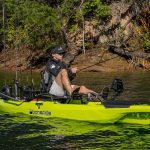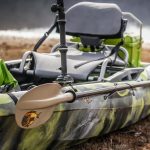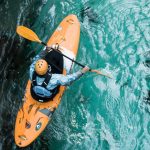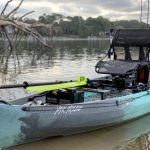Founded in 2016, Bonafide Kayaks is a relative newcomer to the kayak fishing market. 100% made in the USA, their kayaks are known for uncompromised quality and great stability. Let's see what Bonafide Kayaks has to offer in 2023.
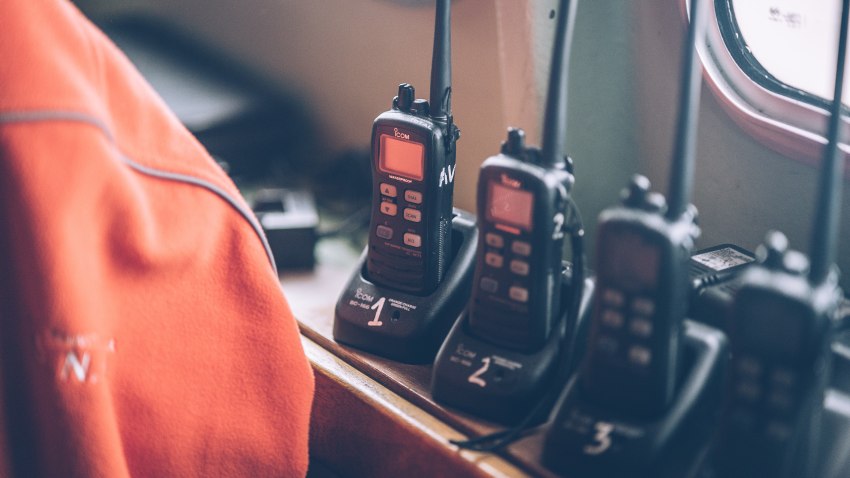
In a hurry? We think Motorola T600 is the best waterproof walkie talkie.
Whether you’re heading out into the open ocean or just exploring some vast lake or fast-flowing river, it’s always important to be prepared for emergencies.
The last thing you want is to end up stranded in the middle of nowhere or out at sea with no way to call for help or alert anyone to your situation.
That’s why a waterproof two way radio is considered an essential piece of safety equipment that you should always carry anywhere you paddle.
It could very well save your life!
Below, we’re going to take a look at the best waterproof walkie talkies on the market (as well as a couple of marine radios), and explain why each is worth considering.
Plus, we’ll explain what to look for in a walkie talkie so you know exactly what features are critical.
By the end, you’ll have all the information you need to choose from our list of the best waterproof walkie talkies.
Happy reading!
As an affiliate of Amazon and other retailers, we may earn a small commission when you buy via our links, at no additional cost to you. Thank you!
Our Winner: Motorola T600 Talkabout Radio, 2 Pack
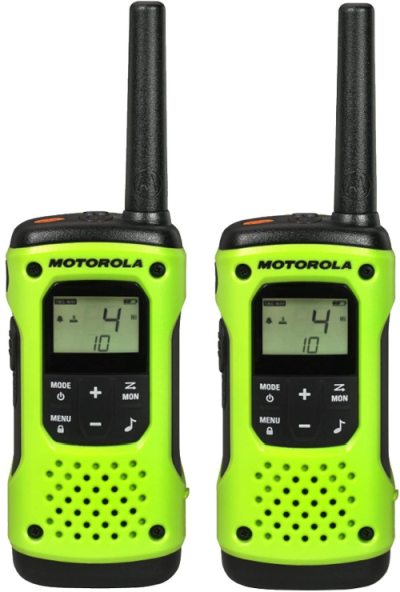
Channels: 22
Range: 35 miles (56.3 km)
Battery Life: 9 hours with NiMH battery, 23 hours with AA Alkaline batteries
Waterproof Rating: IP67
If you want a versatile, durable, highly reliable waterproof walkie talkie to take on your next kayak adventure, I highly recommend the Motorola T600. It’s got everything you want in a walkie talkie: buoyancy, a water-activated flashlight that makes it easier to find in the dark, emergency alert radio feature, a built-in whistle belt clip, white and red LED flashlight, and access to 11 weather channels, including 7 NOAA channels.
It broadcasts across 22 channels, using 121 privacy codes to ensure your conversations aren’t clogged by unwanted devices. The VOX feature makes it work like a speakerphone, great for hands-free communication when out on the water. You can use it to quickly scan to find an active frequency in case of emergency, and it’s compatible with any FRS/GMRS radio, regardless of brand.
With a 35-mile range, it’s an excellent choice to use on the open ocean.
Why Is It the Best?
- Fully waterproof and buoyant
- Packed with emergency, safety, and convenience features
- Decent battery life
- Highly reliable—our best pick for kayakers!
At a Glance: Best Waterproof Walkie Talkies
- Best Overall: Motorola T600 Talkabout Radio, 2 Pack
- Most Comfortable: Backcountry Access BC Link 2.0 Radio
- Best Mid-Range Walkie-Talkie: Midland X-TALKER 36 Channel FRS Two-Way Radio
- Most Feature-Rich: BAOFENG BF-F8HP (UV-5R 3rd Gen) 8-Watt Dual Band Two-Way Radio
- Best Signal Range: Uniden SX507-2CKHS
- Most Reliable Battery: Cobra RX680 2 Watt Rugged Walkie Talkies
- Most Rugged: DEWALT DXFRS300 1 Watt Heavy Duty Walkie Talkies
- Best Budget Walkie-Talkie: Motorola T100 Talkabout Radio, 2 Pack
- Best Marine Radio: Standard Horizon HX210 6W Compact Floating Marine Handheld VHF
- Best Marine Radio for International Travelers: Cobra MR HH350 FLT Handheld Floating VHF Radio
Comparison Table: Best Waterproof Walkie Talkies
| Model | Specs | Where to Buy |
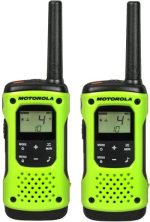 Motorola T600 Talkabout Radio, 2 Pack | Channels: 22 Range: 35 miles Battery Life: – 9 hours with NiMH battery – 23 hours with AA Alkaline batteries Waterproof Rating: IP67 | Amazon |
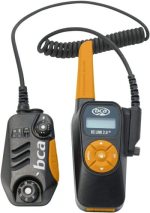 Backcountry Access BC Link 2.0 Radio | Channels: 22 Range: 40 miles Battery Life: 40 hours Waterproof Rating: Unspecified | Amazon |
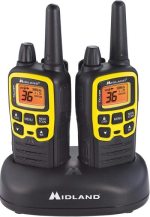 Midland X-TALKER 36 Channel FRS Two-Way Radio | Channels: 36 Range: 32 miles Battery Life: 12 hours Waterproof Rating: Unspecified | Amazon |
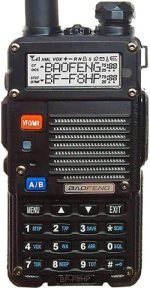 BAOFENG BF-F8HP (UV-5R 3rd Gen) 8-Watt Dual Band Two-Way Radio | Channels: Unspecified Range: 10+ miles Battery Life: up to 24 hours Waterproof Rating: IP67 | Amazon |
 Uniden SX507-2CKHS | Channels: 22 Range: 50 miles Battery Life: 14 hours Waterproof Rating: JIS7 | Amazon |
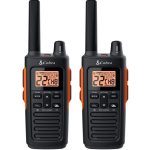 Cobra RX680 2 Watt Rugged Walkie Talkies | Channels: 60 Range: 38 miles Battery Life: 18 hours Waterproof Rating: IP54 | Amazon |
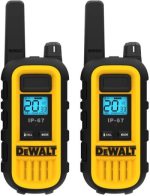 DEWALT DXFRS300 1 Watt Heavy Duty Walkie Talkies | Channels: 22 Range: ~1 mile obstructed Battery Life: 12 hours Waterproof Rating: IP67 | Amazon |
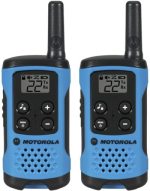 Motorola T100 Talkabout Radio, 2 Pack | Channels: 22 Range: 16 miles Battery Life: 18 hours Waterproof Rating: Unspecified | Amazon |
 Standard Horizon HX210 6W Compact Floating Marine Handheld VHF | Channels: 16 Range: Unspecified Battery Life: 15 hours Waterproof Rating: IPX7 | Amazon |
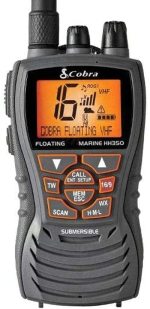 Cobra MR HH350 FLT Handheld Floating VHF Radio | Channels: Instant access to Channels 9 and 16 Range: Unspecified Battery Life: 16+ hours Waterproof Rating: IPX8 | Amazon |
Our Complete List of the Best Waterproof Walkie Talkies:
Best Overall: Motorola T600 Talkabout Radio, 2 Pack

Channels: 22
Range: 35 miles (56.3 km)
Battery Life: 9 hours with NiMH battery, 23 hours with AA Alkaline batteries
Waterproof Rating: IP67
If you want a versatile, durable, highly reliable waterproof walkie talkie to take on your next kayak adventure, I highly recommend the Motorola T600. It’s got everything you want in a walkie talkie: buoyancy, a water-activated flashlight that makes it easier to find in the dark, emergency alert radio feature, a built-in whistle belt clip, white and red LED flashlight, and access to 11 weather channels, including 7 NOAA channels.
It broadcasts across 22 channels, using 121 privacy codes to ensure your conversations aren’t clogged by unwanted devices. The VOX feature makes it work like a speakerphone, great for hands-free communication when out on the water. You can use it to quickly scan to find an active frequency in case of emergency, and it’s compatible with any FRS/GMRS radio, regardless of brand.
With a 35-mile range, it’s an excellent choice to use on the open ocean.
Pros:
- Fully waterproof and buoyant
- Packed with emergency, safety, and convenience features
- Decent battery life
- Highly reliable—our best pick for kayakers!
Cons:
- Menu can be tricky to navigate
- Bulky
Most Comfortable: Backcountry Access BC Link 2.0 Radio
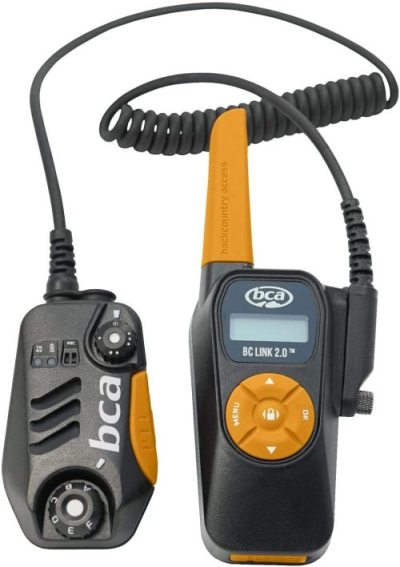
Channels: 22
Range: 40 miles (64.37 km)
Battery Life: 40 hours
Waterproof Rating: Unspecified
What I love about this walkie talkie is that the primary device can be stored safely behind your seat or in the cockpit, but you can clip the handset to your PFD for easy, convenient talking. Though it’s designed more for mountaineers and climbers, it works perfectly on water and has above-average signal range (40 miles unobstructed).
The built-in lithium ion battery makes the device a bit heavy, but gives it a superior battery that keeps it broadcasting at maximum output for up to 40 hours. You can pre-set your preferred channels to activate with the press of a button, and it can even be hooked up to headphones (via the earphone jack) to maximize sound quality and make it easier to hear your conversations.
Pros:
- Great range
- Excellent battery life
- Superior durability
- Resistant to all water and weather conditions
- Easy to clip onto your PFD and talk
Cons:
- Not hands-free/VOX enabled
- Heavy and large
Best Mid-Range Walkie-Talkie: Midland X-TALKER 36 Channel FRS Two-Way Radio
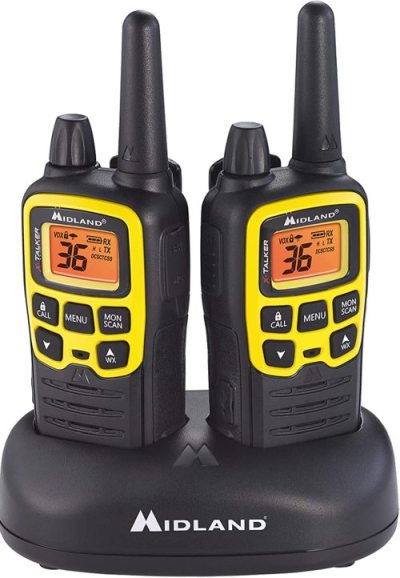
Channels: 36
Range: 32 miles (51.5 km)
Battery Life: 12 hours
Waterproof Rating: No formal IP rating
Kayakers planning a river or lake trip will want to give this Midland walkie talkie careful consideration. It’s water-resistant but not waterproof (no IP rating offered by Midland), so as long as it’s not submerged too deep or for too long in water, it should handle the wet just fine.
Call clarity on this radio is excellent, with crisp sounds and a decent range (32 miles). It offers access to 36 FRS channels, with 121 privacy codes and a Squelch system that will keep your conversations as private as possible. You also get access to 10 NOAA and weather band channels, and it even sounds an alarm if there is a chance of severe weather developing near you.
The VOX feature is perfect for hands-free operation, with 9 sensitivity levels that let you adjust how loud or quiet the activation noise has to be. It includes a rechargeable battery pack but is compatible with AAA batteries as well.
Pros:
- Compact and lightweight
- Solidly built; good water-resistance
- Good product at a reasonable price
- Ideal for lakes and rivers
- Easily clip to your PFD, belt, or pack
Cons:
- Iffy battery life
- No details on IP rating or buoyancy available
Most Feature-Rich: BAOFENG BF-F8HP (UV-5R 3rd Gen) 8-Watt Dual Band Two-Way Radio
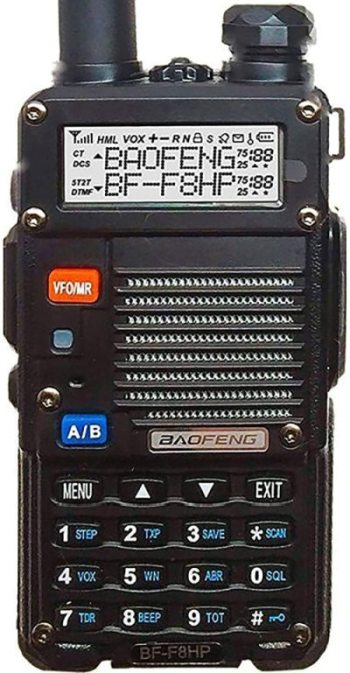
Channels: Unspecified
Range: 10+ miles (16+ km)
Battery Life: up to 24 hours
Waterproof Rating: IP67
This is a truly unique device: it combines both standard walkie talkie functionality with marine VHF radio. That’s right, it can operate in the marine radio frequency range and the standard walkie talkie range. It does require a valid ham operator license in the US, so it’s certainly not the radio for everyone. But kayakers who want a next-level, feature-rich radio should consider it as a top candidate.
The 8-watt radio has a powerful broadcast signal and extra-long antenna, though range is a bit limited compared to some of the other models on this list. Battery life, however, is excellent—up to a full day’s use before it needs recharging. OutdoorGearLab selected it as a “Top Pick” because of its versatility. It’s one of the most capable and customizable of the devices on our list, with an in-depth manual you’ll DEFINITELY have to read in detail to understand just how powerful it is.
Pros:
- Ultra-versatile
- Packed with customizations and pre-set features
- Multiple power settings to boost range or conserve battery
- Reliable and durable
- Well-priced
Cons:
- Steep learning curve
- Requires valid ham operator license with the FCC
Best Signal Range: Uniden SX507-2CKHS

Channels: 22
Range: 50 miles (80.46 km)
Battery Life: 14 hours
Waterproof Rating: JIS7
You won’t find better than the 50-mile range on this walkie talkie! Only marine radios will beat the range, though sadly, the maximum range is traded for low battery life (just 14 hours). However, the rechargeable NiMH batteries have a decent lifespan and will endure years of kayaking adventures on open water.
The walkie talkies are certified waterproof (JIS = Japanese standards, not US). Submerge them under 3 feet of water for up to 30 minutes, and they’ll still be fully operational! They’re designed to float so you can easily retrieve them should they fall overboard.
One very cool feature is Direct Call, which allows you to call anyone in the group (with a multi-pack) without activating the other walkie talkies. It’s a quick-dial sequence that will let you contact just one specific kayaker in your crew—perfect to stay connected individually as well as a group.
Pros:
- Easy to call just one fellow kayaker
- Best-in-industry range
- Durable, superior waterproofing
- 142 privacy codes + NOAA with alerts
- Vibrate alert when someone is trying to contact you
Cons:
- Transmission very spotty at great range
- Instructions difficult to understand
Most Reliable Battery: Cobra RX680 2 Watt Rugged Walkie Talkies
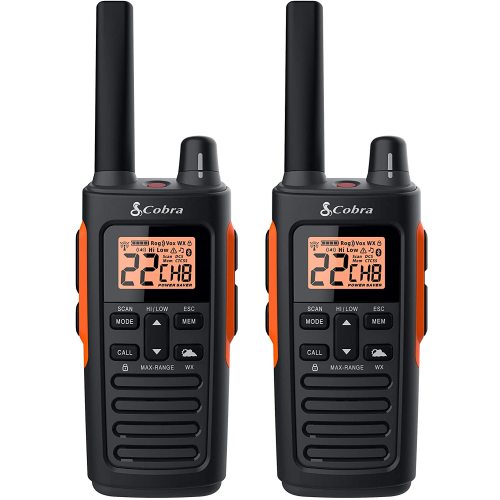
Channels: 60
Range: 38 miles (61.15 km)
Battery Life: 18 hours
Waterproof Rating: IP54
If you want a battery that just won’t quit or fail on you, look no farther than this Cobra set! Let’s be clear: you can find other walkie talkies with longer runtimes, but these batteries will give you more recharge cycles and ultimately a longer lifespan. 18 hours of run time is nothing to sniff at, though, and as long as the battery has juice, the device will broadcast crystal clear audio at an above-average range.
The Cobra walkie talkie also includes 60 channels, 121 privacy codes, 2,662 channel combinations, and a built-in NOAA alert receiver to keep you updated on any storms or inclement weather. It’s also VOX-enabled, with decent waterproofing and dust-proofing. It may not be the BEST on this list, but its quality and reliability earns it an “Honorable Mention” for sure.
Pros:
- Durable, solid build quality
- Waterproof and dust-proof
- Good range
- Superior battery lifespan (MANY recharges)
- Hands-free use
Cons:
- Often sold out on Amazon
- Can be charged via USB, but USB charger isn’t provided
Most Rugged: DEWALT DXFRS300 1 Watt Heavy Duty Walkie Talkies
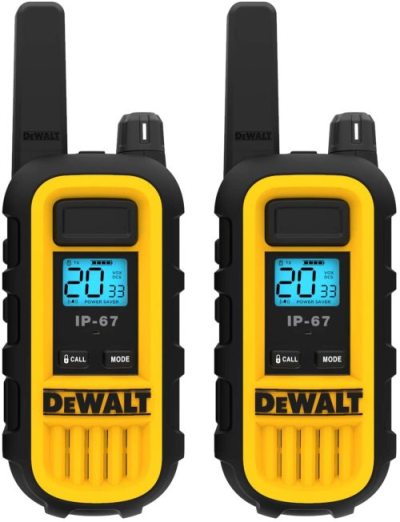
Channels: 22
Range: ~1 mile obstructed (1.6 km)
Battery Life: 12 hours
Waterproof Rating: IP67
This may not be the longest-lasting walkie talkie or have the best signal range, but you’ll find it’s virtually indestructible. It’s not just waterproof (IP67 rating = 1-meter deep water for 30 minutes), but also dust-proof and shock-resistant—drop it from 6 feet high, and it won’t crack, break, or show signs of damage.
The anti-slip design makes it perfect to grip with wet or cold hands, and you’ll find it’s easy to operate with just the press of a button. It’s VOX-enabled, includes a 360-degree swiveling clip so you can secure it to your PFD at just the right angle, and has Auto Squelch to tune out weak and unwanted transmissions.
Though battery life is just 12 hours, it comes with an auto-off feature that switches the walkie talkie to “battery-saving mode” after 10 seconds without transmissions.
Pros:
- The most durable waterproof walkie talkie on the market
- Easy to grip and secure to your kayak/PFD
- Simple operations, decent array of features
- Auto Squelch + VOX
- Drop-in charging
Cons:
- Limited signal range
- Iffy battery life
- No NOAA/weather alerts
Best Budget Walkie-Talkie: Motorola T100 Talkabout Radio, 2 Pack
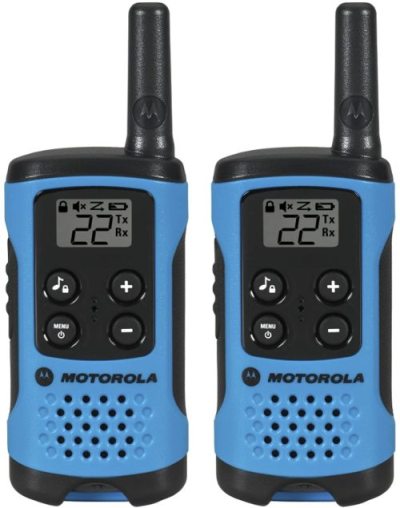
Channels: 22
Range: 16 miles (25.75 km)
Battery Life: 18 hours
Waterproof Rating: Unspecified
Looking for a reliable walkie talkie but want to keep your costs low? Motorola’s got a budget model worth looking at: the T100. It’s a cheaper version of our top-rated pick, the T600, but the low price tag just means there are fewer features, a smaller battery, and shorter range. Durability-wise, however, it’s as good as the best model on our list.
The T100 is lightweight, compact, and clips easily to your belt or vest. It’s also tough and fully waterproof, and made to float in case it falls overboard. It’s got a few great features: low battery flashing alert, auto Squelch, and a time-out timer that will conserve battery power when you stop talking.
Pros:
- Great price, good product
- Small and light
- Easy to operate; simple instructions
- Decent array of features
Cons:
- Not VOX-enabled
- Limited range
Best Marine Radio: Standard Horizon HX210 HX210 6W Compact Floating Marine Handheld VHF
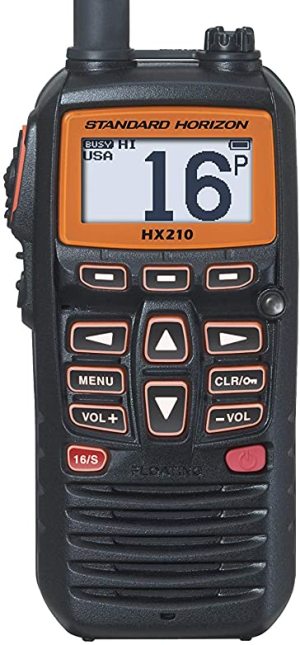
Channels: 16
Range: Unspecified
Battery Life: 15 hours
Waterproof Rating: IPX7
For those who want a reliable marine radio, Standard Horizon has your back. This device comes fully submersible (up to 3.3 feet for 30 minutes), but it’s designed to float on the surface and switch on a flashlight the moment it hits the water.
It includes all US, Canadian, and international VHF channels, including WX and FM radio bands (from 76 to 108 MHz). The high-res dot matrix display is easily legible even in low-light conditions, and you’ll love how easy it is to scroll through the menu to find all the many, many features offered.
The battery life isn’t the best, but like all lithium-ion battery packs, it can be re-charged hundreds of times before it gives out.
Pros:
- Highly durable marine VHF radio
- Backed by a 3-year warranty
- Access all US, Canadian, and international channels
- 3-hour rapid charge time
- Easy to operate menu
Cons:
- Signal range is unspecified (according to reviews, less-than-average for marine radio)
- Quality control issues with battery/charger
Best Marine Radio for International Travelers: Cobra MR HH350 FLT Handheld Floating VHF Radio
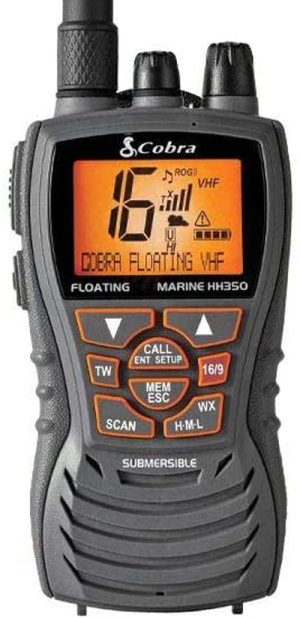
Channels: Instant access to Channels 9 and 16
Range: Unspecified
Battery Life: 16+ hours
Waterproof Rating: IPX8
This marine radio is built for both high visibility in the water and excellent waterproofing—IPX8, a rating higher than most of the others on our list. It can stay 1 meter underwater for 30 minutes without leaking or sustaining damage. Thanks to the bright orange screen and keypad, it’s easy to spot this device floating on the water. Once you’ve retrieved it, hit the “Burp” button to eject any water from the speaker.
It’s built specifically for crystal-clear sound, with a noise-canceling microphone that will block out ambient sound and maximize the clarity of your conversations. You can clip it to your belt or PFD, or just secure it to your arm with the provided wrist strap.
Use it in the US, Canada, or international waters, with access to both Channels 9 and 16 in case of an emergency. You can scan through all available channels to find active transmissions, and even monitor three channels at the same time.
Pros:
- Easily contact fellow watercraft for help in emergency situations
- Superior-quality sound; great noise isolation
- Highly durable and waterproof
- Easy to charge using drop-in cradle
- Excellent standby battery life
Cons:
- Charging cradle can’t travel with you on your kayak
- Poor weather radio reception
The Ultimate Guide to Waterproof Two Way Radios for Kayakers
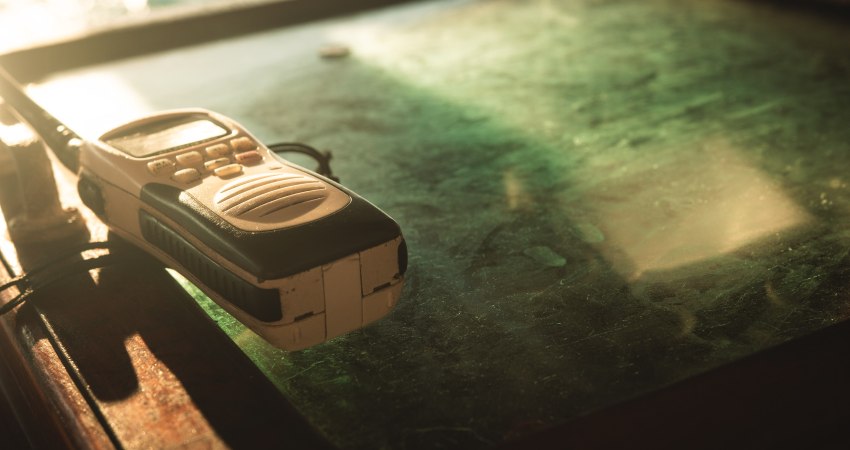
I don’t doubt that you’re familiar with the concept of walkie talkies. Like me, you probably played with them as a kid, pretending to be spies, secret agents, cops, robbers, or (in my case) playing “Radio Tag” in the forest.
But for the sake of this article, I’m going to explain a little bit about how walkie talkies work so you understand exactly why you NEED them for your paddling trips. They’re more than just a toy you used to play with—they’re a life-saving piece of gear.
Let’s start with the basics: what is a walkie talkie and how does it work?
Walkie talkies, also known by their official name of the “handheld transceiver”, are short-to-medium-range two-way radios. Invented during World War II, they’ve become an integral part of virtually every industry—from construction to public safety to commercial operations.
Walkie talkies usually look like a simple handset with a speaker and microphone built in, along with an antenna to broadcast and receive the radio signal. They are called a “half-duplex” device, meaning they can communicate with each other but not at the same time. (Telephones would be considered “full-duplex”.)
They operate on a specific single radio channel, or an assigned frequency used for radio communication. Most two way radios will operate on that one channel, and anyone who can set their walkie talkie to that channel can typically listen in, though only one can transmit voice messages. The “Push to Talk” button set into the walkie talkie switches the handset from “receive” mode to “transmit” mode, which broadcasts the signal via the built-in antenna to all other receiving devices within the signal range.
Well, that’s all the jargon out of the way!
You already knew the basics of how walkie talkies worked, but this explanation will make sense in a little bit (you’ll see what I mean in the “Marine Radio vs. Walkie Talkie” section).
But before we get there, we’ve got to ask and answer a very important question…
Why Do I Need A Walkie Talkie for Kayaking?
The truth is, you don’t need a walkie talkie for all kayaking trips.
Think about it: paddling a small, glass-smooth lake on a calm sunny day doesn’t really sound too dangerous. You’re always within sight of the shoreline, and there are plenty of places where you can land and pull your cell phone out of a dry bag to call for help if necessary.
Yes, in a situation like this, there is absolutely no need for a waterproof walkie talkie. You’re in very little danger and the chances you’ll end up in any serious trouble is ultra-slim.
But it’s always good to have a walkie talkie if you’re traveling with friends. The larger the group, the greater the risk that someone will capsize, get lost, damage their kayak, or fall behind.
On long river floats, they’ll make it easy to stay in touch around bends or forks in the river. Or on a lake tour, when everyone is spread out over long distances, you can use a walkie talkie to keep your group together.
Waterproof Walkie Talkie for Fishing
Walkie talkies are not something that comes to mind when you think about fishing gear. However, they can be surprisingly useful when fishing with friends. If you’re going fishing, the last thing you want is to spook the fish by shouting back and forth. Even if you just want to chat about the views or your next destination, a walkie talkie makes that so much easier.
RELATED: Best Fishing Kayaks for 2023: Reviews and Ultimate Buying Guide
Of course, that leads into the next important question:
Why a Walkie Talkie Instead of a Cell Phone?
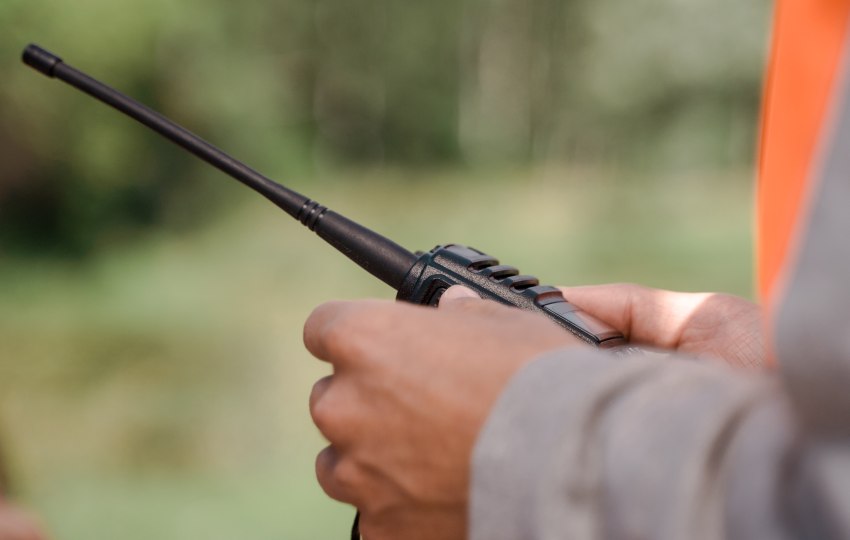
Everyone has a cell phone nowadays, most of them fairly “smart” with a way to call for help using both cellular network and internet data. Dry bags provide an easy solution for bringing your cell phone along everywhere you paddle.
But there are a two reasons cell phones are the less-than-optimal choice for kayakers:
Limited Coverage – It’s not uncommon to find that you’ve got no signal at all before you ever leave shore. A lot of national parks purposely prevent the installation of nearby cell towers to keep the parks wireless-free.
(Here’s a list of cell phone coverage in U.S. National Parks so you can see just how limited it really is…)
Many lakes and rivers will also be in remote locations where it’s just too hard to build a cell tower to provide signal. And, of course, if you’re paddling out into the open ocean, you’ll typically lose cell signal by the time you’re a few miles offshore (depending on the location of the nearest cell tower).
With no signal, your smartphone becomes little more than an excellent music/video player and digital camera, but useless in an emergency.
Walkie talkies, on the other hand, don’t rely on any cellular networks. Their broadcast antennas typically can transmit a signal anywhere from a few hundred yards (for cheap, “toy” quality devices) up to 50 miles. Yes, miles!
As long as the battery has charge and the device is operational, it will give you a way to transmit a signal for a very long range—perfect for emergency situations.
Not Waterproof – Some smartphone manufacturers tout their smartphones as being “water-resistant”, meaning they can withstand a bit of rain—or, in the case of some specially designed models, can be dropped into water without sustaining damage.
Most cell phones, however, lack waterproofing or even water-resistance. If even a few drops of water seep through the screen and casing and get into the electronics, it’ll fry the hardware and turn the cell phone into so much junk.
Kayakers typically keep their smartphones safely in their dry bags, secure from the water. But what if you had to pull it out to call for help while capsized? Or you’re fighting a brutal ocean storm and trying to keep your smartphone from getting wet?
It’s pretty clear that cell phones just don’t cut it when it comes to kayaking, which is why waterproof walkie talkies are a good backup plan in case of a real emergency situation.
Marine Radio vs. Walkie Talkie
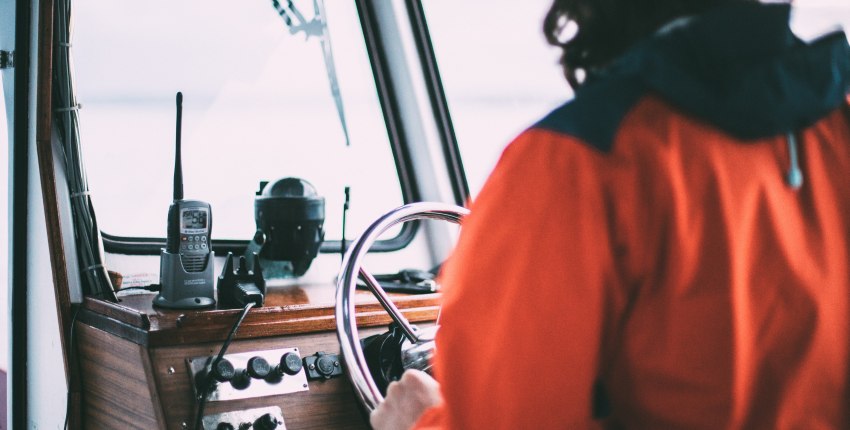
I do want to take a moment to talk about another solution to communicate in emergency situations. Specifically, marine radio.
Marine VHF radio is a communication system used around the world by all ships and watercraft. It’s a two-way talk system similar to walkie talkies, but it operates on very specific Very High Frequency (VHF) radio bands—between 156 and 174 MHz. This is the “VHF maritime mobile band” as designated by the International Telecommunication Union. Walkie talkies, on the other hand, communicate on Ultra-High Frequency (UHF) radio bands–between 462MHz and 467MHz.
All ships and larger watercraft are required to have marine radio on board, but smaller craft (boats used for diving, fishing, water skiing, sport fishing, and, of course, kayaks) may equip marine VHF radios by choice.
Typically, marine radio has a signal range of up to 62 miles (100 kilometers or 54 nautical miles). The range is much greater than walkie talkies, and the chances of your emergency call being picked up by nearby watercraft is also higher.
In the United States, there is no need to obtain a license to operate marine radio (unless you use a specific type of radio with Digital Selective Calling capability). In Canada, however, you’ll need to get a Restricted Radiotelephone Operator’s Certification.
Marine radios can come in handy in a number of situations:
Getting lost – Let’s be honest, it’s not too difficult to get lost paddling out to sea. Having a marine radio will enable you to call back to shore to get help—or, at the very least, help you find your way back to safety.
Getting stranded – If your kayak gets damaged (by sweepers, strainers, underwater obstacles, or overhangs), you might start taking on water and be forced to put ashore someplace remote with no way to get back to where you put in. This is when you’ll definitely want a way to call for help.
Getting pulled out to sea – Even if you plan just to enjoy a calm day of ocean paddling close to shore, there is always a risk that some current or riptide can drag you out to sea. Being prepared with a waterproof marine radio could facilitate a rescue or help you navigate back to safety.
Capsizing – Anytime you paddle out onto the water, even calm lake waters, there is a risk of capsizing. One wrong movement could throw off your balance and tip your kayak over. If you aren’t able to self-rescue (righting your kayak, bailing out the water, etc.), you may find it’s easier to call for help than have to swim miles back to shore.
RELATED: 8 Best Inflatable Life Jackets for Kayaking [2023]
Long-distance travel – Planning on going island-hopping or paddling out to some cool-looking landmark far from the shore? The farther you are from the shore and civilization, the more you will depend on a way to call for help in case of an emergency situation.
Most marine radios let you contact the U.S. Coast Guard via VHF-FM Channel 16 (156.8 MHz), which is the equivalent of 911 for boats. Walkie talkies, however, don’t operate in this particular frequency (they’re ULTRA-High Frequency, not VERY-High Frequency like marine radios), and so cannot be used to call the Coast Guard for help.
Note: The U.S. Coast Guard website has an excellent step-by-step guide on the proper procedure for calling for help using a VHF marine radio.
Typically, kayakers planning long-distance open ocean travel will opt for a marine radio, while kayakers paddling rivers and lakes inland will stick with walkie talkies.
Because marine radios are a good option to consider, we’ve included a couple of our top recommendations on our list below.
Waterproof Walkie Talkie Features to Consider
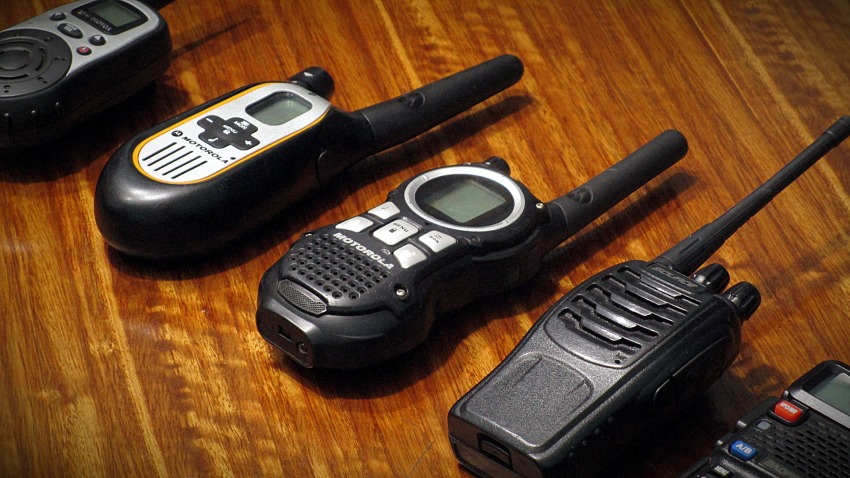
Now that you know you need a walkie talkie (or marine VHF radio), it’s time to narrow down your options further.
I want to explain each of the most critical factors to consider when shopping for a walkie talkie so you know exactly how to find the “best” choice for your specific needs.
Battery Type + Life – Two-way radios will typically use either one of three battery types:
- Nickel Cadmium, or Ni-Cad. These are cheap, have a long lifespan, and can typically handle multiple re-charges. However, they’re also heavier than the other battery types and due to “memory burn” will hold less and less charge over time. Their average lifespan is 2-3 years.
- Lithium Ion, or Li-Ion. These are the most expensive batteries, but are smaller, lighter, hold more charge, and don’t suffer memory burn. However, they are only useful for a specific number of charge cycles, after which time they won’t re-charge at all. They also require a specific type of charger.
- Nickel Metal Hydride. These are the “mid-range” batteries, smaller and lighter than Ni-Cad, but as resistant to memory burn as Li-Ion. They have a lifespan of around 1-2 years.
Most waterproof walkie talkies will use some sort of battery “pack” inside a waterproof casing. However, some (especially the budget models) will use AA or AAA batteries. These typically have a shorter lifespan but are far cheaper to keep powered. You can actually bring spare batteries on your kayak to switch out if the radio loses power.
Battery life is one of the most important factors to consider when shopping for a walkie talkie. You want a device that will hold a charge as long as possible, because as long as it’s charged up, you can send and receive signals. The lower the battery level drops, the shorter the broadcasting range.
Waterproofing – If you take a look at any waterproof or water-resistant device, you’ll see that they feature a specific IP (International Protection or Ingress Protection) rating.
Always, it will be the letters “IP” followed by an optional letter (typically X) and two digits. These numbers define the degree of protection provided against not just water, but also dust, accidental contact, and even the instruction of solid objects (like your fingers).
You can actually learn to translate the IP ratings at a single glance by referring to the information provided by this fascinating page on the DSMT website.
But if you’re like me and just want the quick version, here’s what you need to know:
Most waterproof walkie talkies with feature one of the following ratings:
The higher the rating (particularly of the second digit), the better the water-proofing!
Signal Range – It’s probably safe to say that you’re not looking for a “toy”-grade walkie talkie, but one better-suited to taking out on the water.
The sort of waterproof walkie talkies typically used by kayakers will have an average range of 15-38 miles, though some can reach as high as 50 miles.
You definitely don’t need an explanation as to why a longer signal range is better. However, you do need to know that broadcasting a signal over a longer range drains more power from the battery. It’s a trade-off you need to be aware of when factoring in both the battery life and signal range.
Note: If you want to increase your signal range, you can A) install a larger antenna, B) use a signal repeater to add power to your signal broadcast, and C) keep your batteries topped up and as fresh as possible.
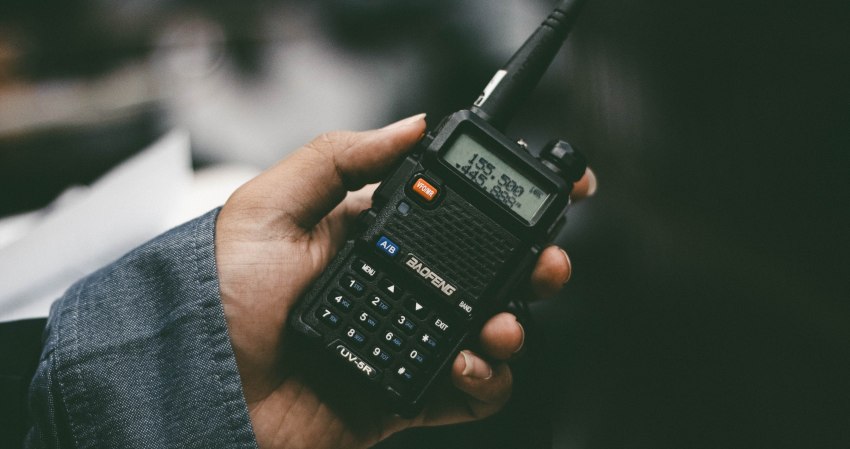
Channels – Walkie talkies operate within a pretty broad range of frequencies: from 136 MHz to 900 MHz. That gives you a lot of options to make contact with people in case of an emergency.
But many devices opt for “private” channels that operate on a very specific sub-frequency and require a code to access. This is intended to keep the two-way communication between paired handsets private, letting you filter out other conversations on similar channels.
More channels to choose from will help you to keep your signal clear of interference or static from other devices broadcasting at a similar frequency range. It also gives you more options to broadcast an emergency signal that could be picked up by other devices within range.
Emergency Features – Waterproof walkie talkies are designed to be used for watersports, fishing, boating, and other recreational activities where it’s assumed you might need to call for help in an emergency situation. Thus, they feature any number of emergency features, including:
- SOS Morse code transmission across all channels
- Audio/visual beacons (such as a blinking light or feedback echo)
- Loud noise transmission across all channels
These are features that will help you in case you find yourself in trouble, and very worth considering when walkie talkie-shopping.
Weather Readings/NOAA Alerts – Just because your morning of kayaking starts out with beautiful weather, that doesn’t mean it’ll stay sunny and calm all day long. You can’t check your phone to see weather updates (no signal/stuck in the dry bag), but thankfully, a lot of walkie talkies come with a built-in feature that will display both weather readings (temperature, humidity, etc.) and alerts from the National Oceanic and Atmospheric Association. You’ll get up-to-the-minute broadcasts and updates on any inclement weather, oncoming storms, or temperature/humidity changes that could lead to danger.
This is a very handy feature to have when long-distance paddling (such as island-hopping or expedition kayaking) or traversing a river. It can warn you to get to shelter, safety, or dry land before the weather turns nasty!
Built-in GPS – Just because you’ve got a way to radio for help, that doesn’t mean you’re going to be easily rescued in the middle of the ocean or wilderness. You could have drifted miles off course or gotten your directions so turned around that you have no way to accurately direct emergency rescue personnel to your location.
No way without a GPS, that is!
Some of the higher-end waterproof walkie talkies come with built-in GPS devices. Knowing your GPS coordinates will make it much easier to bring rescue personnel straight to your location in a hurry.
ALSO SEE: When GPS Fails: Best Kayak Compass in 2023
Weight and Size – This is a minor factor, but one to consider nonetheless. A big, bulky, heavy walkie talkie will take up limited storage space and add extra weight on top of the rest of your gear. Small, lightweight walkie talkies can actually be clipped to your PFD without getting in the way.
However, one thing to keep in mind: the bigger the walkie talkie, the more feature-rich it may be, and the greater potential battery life. The extra size and weight may be a trade-off worth accepting in certain circumstances.
Buoyancy – You never realize how important this particular feature is until it’s too late!
I can picture it so clearly: you’re in a situation where you need to call for help, but somehow you lose your grip on the walkie talkie and it drops over the side of your kayak. In the water it goes, and because it can’t float, it sinks straight to the bottom of the ocean.
Buoyancy is an absolute MUST for waterproof walkie talkies. It should at least be able to float near the surface and within reach so you can retrieve it on the off-chance it falls overboard.
VOX – VOX, or Voice Operated Exchange, is a feature that activates the walkie talkie hands-free. Essentially, it allows you to talk without the need to push the button, but activates when it picks up the sound of your voice and automatically starts broadcasting.
There are some downsides to VOX—it is noise-activated, so background sound may cause it to start broadcasting, which can drain your battery quicker than you realize. However, most VOX-enabled handsets also include a feature that let you switch between VOX and PTT (button-operated activation) so you can prevent unnecessary chatter in loud environments.
Squelch – Squelch is a highly useful circuit function that suppresses unwanted radio transmissions. It’s a noise gate that prevents weak signals from being picked up by your radio, but only pick up active transmissions. It’s a handy feature to have if you’re kayaking in a location where there may a lot of other people also using walkie talkies
Dust Protection – Dust isn’t going to be your biggest concern while out on the water, but there is still the risk that your walkie talkie could get damaged on dry land (if you drop it in the sand or are in a windy area) without proper dust protection.
The first of the two digits in the IP rating will tell you how dust-protected it is. Typically, a 5 or 6 is enough to keep your walkie talkie from sustaining dust damage.
Warranty – Last but not least, you should consider the walkie talkie’s warranty. A longer warranty typically applies to products a manufacturer believes has a longer lifespan, meaning less prone to sustaining damage that could cause defects or total breakage.
Typically, you want to find a walkie talkie with AT LEAST 1-2 years of warranty coverage. The higher-end models will typically cost more but also include a longer warranty. Budget models may have shorter warranties because the components used are cheaper and more prone to damage.

